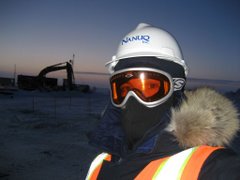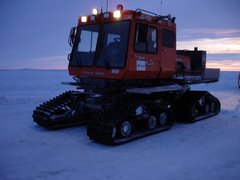


(while looking East)




So... despite telling people that I was working on a blog... this has turned out to be yet another chance to say "Better late than never?" Apologies for taking so long to get something out to all you kind folks that have been wondering where the hell I am and what ever in the world I've been up to. I'll claim averaging ~ 90 hours a week since the first week of January as my excuse.
It's been a long hard Winter up here. I suppose that seems a bit silly to say given my surroundings but I have to admit I didn't expect things to be as challenging as they have been. Now... for those of you that I've spoken to on the phone recently... don't worry! I didn't start this blog to continue the tirades that I've tended towards over the past few (gulp) months (yikes!) The challenges haven't risen from the weather. They've stemmed more from the consistently long hours (12 hours/day, 7 days/week at a minimum) and the fact that the key to success on the North Slope of Alaska (aka the Slope) is to be the biggest jerk with the least amount of scruples... not something I've set myself to excel at in life... no comments from the peanut gallery.
As with all twists and turns in life there is allways a positive outcome to all situations. At the very least I know what I don't want to spend the rest of my life doing. I've also picked up the following useful information:
That's all for my first post. My goal is to sort through the many photos I've taken and write about the circumstances surrounding the photo itself, the happenings of that day, etc. I may have lost the "fresh take" on my time up here but perhaps you've already gathered from my previous comments that time and a wee bit of perspective is a good thing.
Ah! One more thing... I'm currently living in a construction camp in the Native Village of Nuiqsut. Here is a link to the May 2006 NG cover article discussing the section of the oil field we are in and the impact on Nuiqsut:
http://www7.nationalgeographic.com/ngm/0605/feature1/
It's very informative. I have a few comments on the topics covered that I'll post at a later time.
Hope everyone is well.


